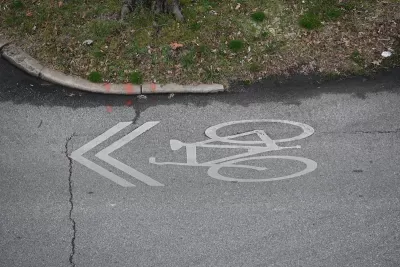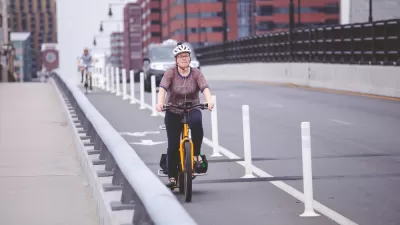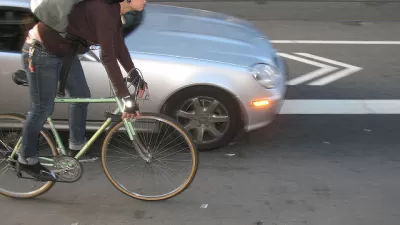Research shows there’s no substitute for protected bike lanes, and sharrows may make roads more dangerous for cyclists.

Once a positive step for bike infrastructure, sharrows — “those little bike-shaped icons painted onto roads that are supposed to indicate where cyclists should ride” — are falling out of favor and could actually endanger people on bikes.
According to an article in Momentum, “Studies have shown that sharrows don’t actually provide any real safety benefits for cyclists. In fact, they may even make things worse by encouraging drivers to pass cyclists too closely.”
Dave Snyder, senior director of People For Bikes and a formerly passionate advocate for sharrows, has admitted that they haven’t worked. “Today, we know so much more about what it takes to make our streets safer for bicycling. We need separate bike paths; we need protected bike lanes on busy roads; and where the lanes are shared, we need actual speeds reduced to 20 mph or slower.”
The article concludes that there’s no substitute for safe, physically protected bike lanes. “The best bicycle infrastructure for safe cycling is dedicated bike lanes that provide physical separation between cyclists and vehicles.
FULL STORY: Sharrows used to make sense in theory, but are now mostly useless and possibly dangerous

Alabama: Trump Terminates Settlements for Black Communities Harmed By Raw Sewage
Trump deemed the landmark civil rights agreement “illegal DEI and environmental justice policy.”

Planetizen Federal Action Tracker
A weekly monitor of how Trump’s orders and actions are impacting planners and planning in America.

How Atlanta Built 7,000 Housing Units in 3 Years
The city’s comprehensive, neighborhood-focused housing strategy focuses on identifying properties and land that can be repurposed for housing and encouraging development in underserved neighborhoods.

Report: Zoning Reforms Should Complement Nashville’s Ambitious Transit Plan
Without reform, restrictive zoning codes will limit the impact of the city’s planned transit expansion and could exclude some of the residents who depend on transit the most.

Judge Orders Release of Frozen IRA, IIJA Funding
The decision is a victory for environmental groups who charged that freezing funds for critical infrastructure and disaster response programs caused “real and irreparable harm” to communities.

‘Clybourne Park’ Sets Stage for Housing Equity Discussions
Clybourne Park, a play exploring race, real estate, and community tensions, can set the stage for discussion on the lasting impacts of housing discrimination, gentrification, and the fight for affordability.
Urban Design for Planners 1: Software Tools
This six-course series explores essential urban design concepts using open source software and equips planners with the tools they need to participate fully in the urban design process.
Planning for Universal Design
Learn the tools for implementing Universal Design in planning regulations.
Caltrans
Smith Gee Studio
Institute for Housing and Urban Development Studies (IHS)
City of Grandview
Harvard GSD Executive Education
Toledo-Lucas County Plan Commissions
Salt Lake City
NYU Wagner Graduate School of Public Service





























